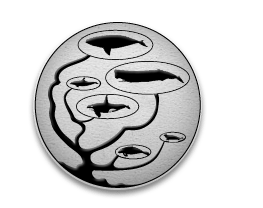The rearticulation of a bottlenose dolphin skeleton
by Keith Rittmaster and Leonard DeDuke, 5 March, 1997
 On May 11, 1993, Keith Rittmaster, Natural Science Curator of the NC Maritime Museum, discovered a dead bottlenose dolphin carcass washed ashore at Cape Lookout. Keith performed a necropsy to determine the sex, approximate age, possible cause of death, and to take tissue samples and measurements. It was a post-partum adult female, 260 cm long. The cause of death was not determined. Tissue samples (gonads and stomach) were sent to the Beaufort NMFS lab for analysis. Then students from Halifax Academy, Roanoke Rapids, NC assisted Keith in burying the carcass under approximately 1 meter of sand behind the primary dune on 1/4″ mesh hardware cloth.
On May 11, 1993, Keith Rittmaster, Natural Science Curator of the NC Maritime Museum, discovered a dead bottlenose dolphin carcass washed ashore at Cape Lookout. Keith performed a necropsy to determine the sex, approximate age, possible cause of death, and to take tissue samples and measurements. It was a post-partum adult female, 260 cm long. The cause of death was not determined. Tissue samples (gonads and stomach) were sent to the Beaufort NMFS lab for analysis. Then students from Halifax Academy, Roanoke Rapids, NC assisted Keith in burying the carcass under approximately 1 meter of sand behind the primary dune on 1/4″ mesh hardware cloth.
On May 21, 1994, students from Halifax Academy returned to help Keith exhume the grave. After a year, very little flesh or residual tissue remained. 16 people divided into teams of 2-3 focused on specific aspects of the skeleton. Each arcade of teeth was pressed into a labeled piece of styrofoam. The vertebral column was strung together in order with nylon twine. Hardware cloth envelopes were made and labeled for the flippers, hyoid bones, sternebrae, caudal vertebrae, and pelvic bones. Ribs and costal bones were labeled and tied together in order. The chevrons were assembled in order, photographed, labeled, and placed in a hardware cloth envelope.
Keith brought the bones back to the museum, scrubbed them, and soaked them for two weeks in a weak (10%) solution of household ammonia. Then they were air dried in the sun.
Museum Volunteer Leonard DeDuke undertook the task of rearticulating the bottlenose dolphin skeleton with advice from Charley Potter from the Smithsonian Institution, Bill McLellan and Ann Pabst from UNC Wilmington, Sentiel Rommel, and various publications on the subject. A 1/4″ stainless steel rod runs through the entire length of the vertebral column. Felt pads were used to represent the intervertebral discs. Wires and Marine Tex adhesive were used to attach most of the other bones together.
Notice there are no bones in the lateral extensions of the tail (flukes) nor in the dorsal fin which are soft tissue in the living specimen. These appendages are highly vascular and used for swimming and thermoregulation. Also notice that near the back of the vertebral column that some of the vertebrae are fused. This may have been a result of an injury or disease, and perhaps a contributing factor in the dolphin’s death, or, as is often the case in dolphins, a normal condition of aging. Also note one of the ribs on the dolphin’s right side was fractured. This was repaired in the rearticulation, but may have contributed to the dolphins’ death. On the same rib notice a previous fracture that was healed in life.
A rearticulated bottlenose dolphin skeleton such as this one has tremendous educational and scientific value. It provides students and scientists the opportunity to study the evolution, comparative anatomy, and bone disorders of these animals. Public displays are an excellent means for increasing public awareness of marine mammals. Since the dolphin is a mammal, it’s bones are similar to other mammals, including humans. There are, of course, some differences between dolphin skeletons and other mammals. One of those differences is the presence of the chevron bones on the undersurface of the caudal (or tail) vertebrae. These bones serve as sites for muscle attachment used in the downstroke in swimming. Notice that the flipper has the similar bones (humerus, radius, ulna, phalanges) found in other mammals, including humans. These bones, however, are relatively smaller in the dolphin and reflect adaptations for life in a marine environment.
The study of a specimen such as this one also assists in the behavioral interpretations of observations in the wild. For example, a dolphin’s physical limitations are not obvious in the wild but an understanding of these limitations through skeletal studies will help us understand the relationships between biology, anatomy, and behavior.
To complete this project, from the necropsy on the beach to the final hanging of the bottlenose dolphin skeleton display took approximately 300 people hours. The cost of materials was approximately $300. Leonard is not interested in rearticulating another bottlenose dolphin skeleton but said he may be interested in trying a large whale next.

